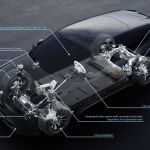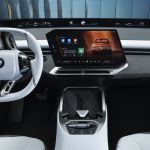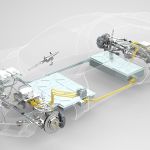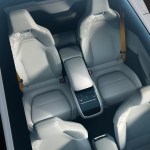The new Italian company specializes in producing luxury cars hand-crafted from carbon fiber with a mission to combine modern technologies with classic design. The GT Series is its first car, a modern environmentally friendly Gran Turismo based on the design of one of the most iconic Italian cars of the 1960s and 1970s, the Alfa Romeo Giulia GTA. The original was introduced in 1965 and, in the following seven years, had many racing victories, leading the car to be considered a legend in the automotive world.
“The process of building these works of art—as I like to call them—requires immense effort, it is not easy,” said Riccardo Quaggio, Founder & CEO of Totem. “I am deeply proud of my team, who face the daily challenges with commitment, responsibility, and great passion. This demonstrates that Italian companies can still, today, stand out in a complicated and highly competitive sector like the automotive industry.”
Totem says its goal isn’t just to bring the latest “restomod” to the market but to redesign it from scratch in the spirit of the original by giving new life to a silhouette from the golden era of racing with high-end automotive engineering. The company worked with technical partners Italtecnica, Novaprogetti, and Revive Automotive to develop the car.
Starting from a small part of the original steel chassis, all of the Totem GT Series’ external body is reconstructed in carbon fiber to make the car as light as possible and obtain a perfectly smooth surface. Coupled with the carbon-fiber monocoque are all-new CNC aluminum chassis and double-wishbone suspension schemes front and rear. The carbon-fiber body panels are supplemented by carbon-fiber doors reinforced with aramid fiber for safety. Exterior lighting is by LEDs.
The resulting car is 4275 mm (168.3 in) long, 1859 mm (73.2 in) wide, and 1.316 mm (51.8 in) tall on a 2500-mm (98.4-in) wheelbase. Weight is 1490 kg (3285 lb).
Engineers remove the “old-fashioned” gasoline engine of the donor car, replacing it with a choice of two internal combustion engines (ICEs) or full electric propulsion, keeping rear-wheel drive. The ICEs are a 600-hp (447-kW) 2.8-L V6 good for 0-100 km/h (0-62 mph) acceleration in 3.2 s or an 810-hp (604-kW) 3.2-L V6 for 0-100 km/h in 2.6 s.
The GT Electric like Armonia gets a powertrain with 590 hp (440 kW) and 900 N·m (664 lb·ft) to accelerate from 0 to 100 km/h in just 2.9 s. Top speed is electronically limited to 210 km/h (130 mph).
A “DNA” system manages electric propulsion via three settings: D (Dynamic), N (Normal), and A (Advance Efficiency). Power unit control is by a Totem ECU “with OEM quality standards,” it has an integrated inverter, and runs up to 400 V and 1100 A.
The battery pack consists of 12 modules homologated to UN38.3 safety testing methods with an 81-kW·h capacity and a claimed best-in-class mass of only 352 kg (776 lb) thanks to its honeycomb aluminum case. The high-voltage wiring system connects all the components through what’s said to be one of the most compact and refined high-voltage junction boxes ever designed.
The GT Electric can be charged at home in AC mode with an onboard single-phase charger at up to 6.6 kW, and in DC fast-charging mode at up to 90 kW using a CCS plug. The car’s range on a full charge is 400-500 km or 250-300 mi “at a standard pace.”
Front and rear axles feature billet aluminum Totem-designed double wishbone suspensions and R53 Engineering dampers. The 18-in billet aluminum mono-block alloy wheel in GTA or Millerighe designs is wrapped by Pirelli P Zero or Michelin SportCup2 tires.
The brakes use Brembo aluminum monobloc fixed calipers with cross-drilled and internally vented brake discs all around, the front with six-piston calipers and with 355 x 32 mm discs, and the rear with four-piston calipers and rear 345 x 28 mm discs. The ABS is by a Bosch Motorsport M5 unit with 12 pre-programmed positions.
Inside are “vintage look” carbon-fiber-frame seats by Sabelt and an infotainment system with a 3.5-in screen featuring Google Maps and Bluetooth/USB connectivity. The Audio Development Hi-fi audio system features two door speakers (woofer and mid-woofer) and two A-pillar tweeters. The rear luggage compartment volume is 165 L (5.8 ft³) and can be accessorized with custom luggage by Testoni.
- Totem Automobili GT Electric front.
- Totem Automobili GT Electric at Villa Erba.
- Totem Automobili GT Electric front side at Villa Erba.
- Totem Automobili GT Electric on the road.
- Totem Automobili GT Electric front blocked.
- Totem Automobili GT Electric outside looking in.
- Totem Automobili GT Electric interior.
- Totem Automobili GT Electric trunk hinge.







































































































